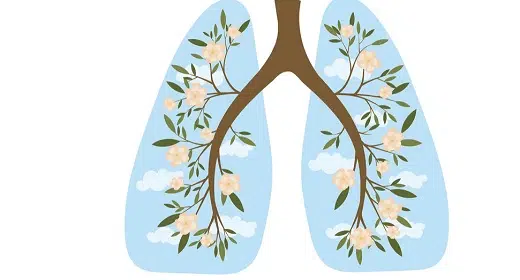by Ni-Cheng Liang: This easy breathing practice helps to release stagnant air in the lungs and find calm…
The 4-7-8 breath was introduced originally by Dr. Andrew Weil who was really considered the grandfather of integrative medicine and as a pulmonologist who’s also a current University of Arizona Integrative Medicine Fellowship fellow. The 4-7-8 breath can be used for situations when you’re feeling particularly anxious, stressed, and even if you have some difficulty falling asleep.
The 4-7-8 breath stands for the following. You inhale for a count of four, then you hold your breath for a count of seven, and then you exhale through your mouth through pursed lips for a count of eight. The durations of these breaths aren’t as important as the ratio of the inhalation breath, breath-hold, and particularly the exhalation breath. The exhalation breath, you’ll notice, is twice as long as the inhalation breath. This allows for the lungs to completely empty of stagnant air, and oftentimes people who have chronic lung disease, particularly those with obstructive lung disease, have a tendency to air trap. This 4-7-8 breathing meditation offers the opportunity to completely exhale.
The 4-7-8 breath can be used for situations when you’re feeling particularly anxious, stressed, and even if you have some difficulty falling asleep.
It’s also a much more intentional practice. If, for instance, awareness of breath might be anxiety-provoking, particularly for lung disease patients, which has been the case for some of my patients, then perhaps a 4-7-8 breath would be more helpful. Pursing your lips when you exhale has been shown to basically stent open the airways. This type of breathing also activates your vagus nerve, which is your “rest and digest” nerve.
A Guided 4-7-8 Breathing Meditation
A 12-Minute 4-7-8 Breathing Meditation
- Sit or stand in a position of comfort. You can close your eyes if that feels safe for you to do so or lower your gaze a few inches in front of you. Perhaps sit more upright, envisioning this string that’s pulling the crown of the head upwards toward the sky, running down through the spine. Checking in and making sure that the head is atop shoulders that are atop the hips. This allows your lungs to be in better anatomic alignment to maximize their ability to exchange air.
- We’ll exhale out through the mouth and then to start, you’ll inhale through your nose for a count of four. One, two, three, four. Hold the breath, two, three, four, five, six, seven. And then out through your mouth, through pursed lips, two, three, four, five, six, seven, eight.
- We’ll do that three more times.
- Exhale once again, and then inhale through the nose. Hold your breath. Then exhale through your mouth. Inhale into the nose. Hold the breath. And exhale through your mouth. One more time, inhale through the nose. Hold the breath. And exhale through the mouth.
- And then return to a normal rhythm of breathing. Perhaps checking in and noticing how you feel now compared to just a few breath cycles ago. Notice the body sensations now. Notice any emotions. Notice your sense of being right now in this moment after the 4-7-8 breath.
The recommended number of times to do this type of breathing meditation is going through four breath cycles up to twice a day initially. Sometimes, if you do more than that, it can cause some lightheadedness and dizziness. If that should happen, you can definitely decrease the number of breath cycles you do with the 4-7-8 breath and slowly build up. But perhaps this is a breathing technique that you might want to try before you do your daily mindfulness practice. Incorporating an intentional, mindful type of breathing before your formal practice. The invitation is there, the choice is yours.





















































